Campervan electrics is a massive part of converting a van. This post is a complete introduction, providing a solid foundation so you can begin to spec, design and install your own DIY electrical system.
A major part of any camper van conversion is the electrical system.
Design decisions will affect your van life so it’s vital to get the electric system right at an early stage.
Even if someone else is converting it, understanding the basics of campervan electrics will help you avoid under or over specifying the system.
The main differences between campervan and household electrical systems are:
- Supply | Household supply is pretty much unlimited so you can use as much as you like. In a campervan, you need to manage the supply and battery levels yourself.
- Voltage | The voltage delivered into a house is much greater than in a camper. At home, 240v or 110v of AC current allows a kettle of water to boil in a couple of minutes. A 12v DC kettle in a camper will take as much as 20 minutes and a big drain on the batteries.
Managing the supply and usage of electricity becomes an integral part of van life.
This article is an introduction to everything you need to know about campervan electrics.
It’ll help you design the right system for the van life you want.
Did you know we published the Campervan Electrics Handbook? It literally has everything you need to completely understand your electrical system, design a fit-for-purpose setup, install and troubleshoot on the road.
We’ve drawn out our campervan wiring diagram here.
If you want to see our detailed electrical design, the electrical outlets we’ve installed and solar panel setup, that’s the post you need.
Overview of Campervan Electrics
This diagram explains campervan electrics in simple terms.
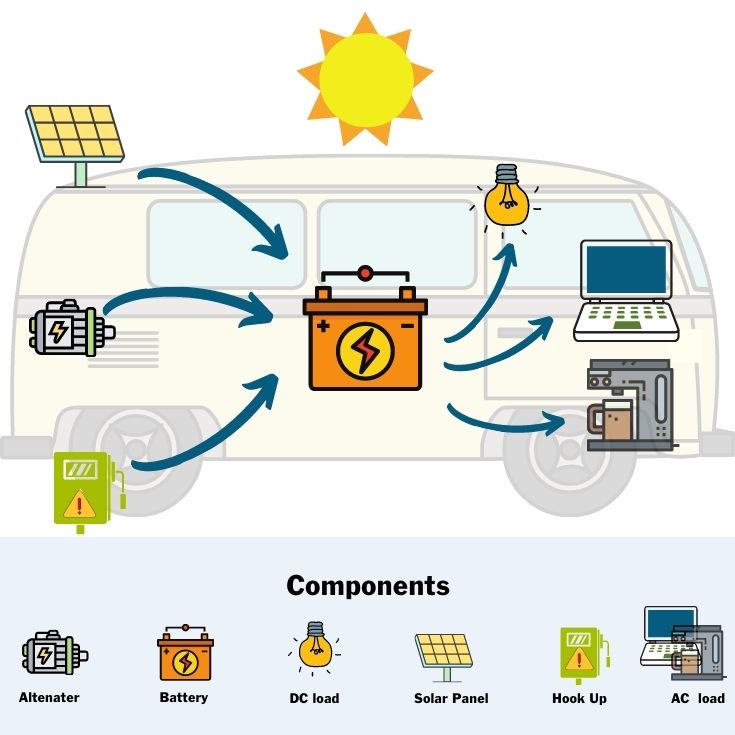
The campervan electrical system revolves around onboard 12v leisure batteries.
The batteries can be charged when driving, by solar panels, by hooking up to a mains power supply or by all 3.
Campervan gadgets and appliances are powered by the stored energy in the batteries.
Some setups can become much more complex than this but by way of an introduction, this is as basic as it gets.
To design an electrical system to suit your needs, it’s essential to understand your demand for energy, power consumption, if you can store enough batteries to meet these needs and importantly, how to recharge them.
Get these things right on paper to avoid disappointment once you hit the road and begin living in the van.
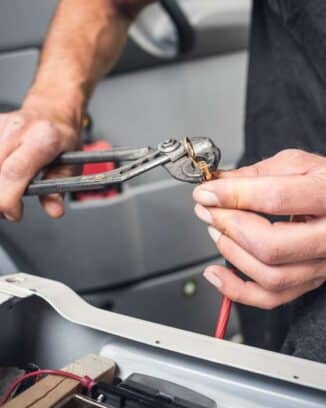
Need help & advice with your electrical setup?
Join Our Facebook Support Group
How Much Electric Do You Need in your Campervan?
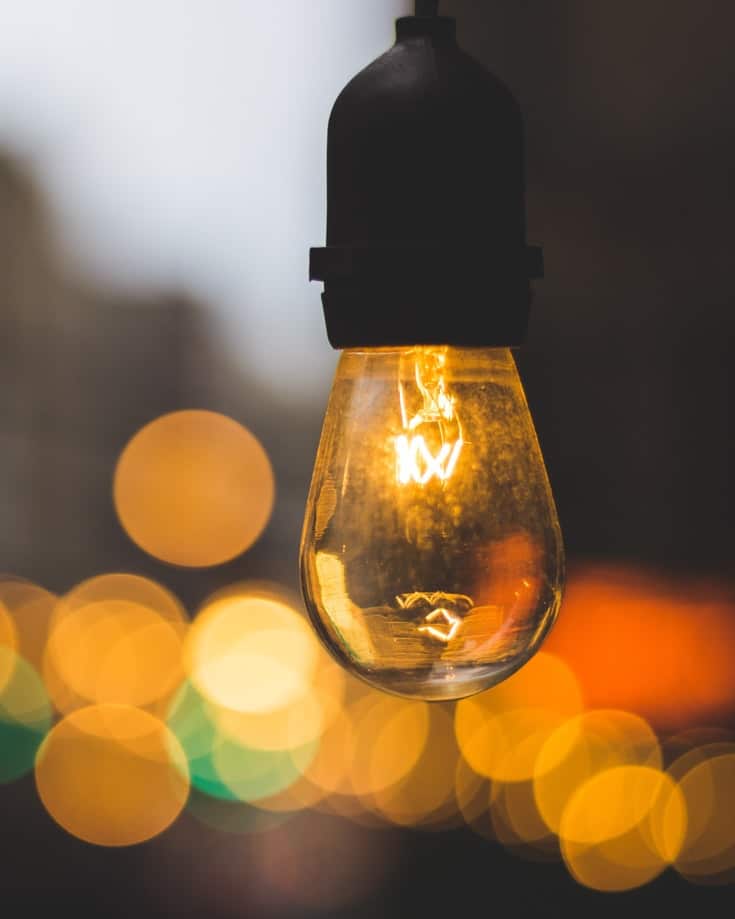
Figuring out how much power you’ll use is the first consideration in any campervan electrical design.
It’s the only way to have confidence the entire system will meet your needs.
The whole calculation can seem quite complicated.
We’ve explained it here in simple terms but we’ve also built an interactive calculator to make it easy. Just hit the button below the explanation.
- Make a list of every electrical appliance and gadget you’ll use in your camper
- Identify the amps each appliance uses. Some appliances state amps, others state the usage in watts. To calculate amps, divide the watts by volts. For example, an appliance is 6 watts, your batteries are 12 volts. 6 divided by 12 (watts divided by volts) is 0.5 amps
- For any household (AC) appliances, multiply the answer by 1.2 to allow for the conversion costs of AC to DC power
- Estimate the number of hours each day the appliance will be in use
- Multiply amps (from step 3) by hours (from step 4) to calculate the total amps needed per day for each appliance
- Add together all amps needed per day. This gives you the total amp hours per day you expect to use
- Some days you’ll use more energy than others so add some contingency. We add 20% but you might want to add a little more or less for yourself. To add 20%, multiply total amp hours by 1.2
What Size Battery Do I Need?

Batteries are measured in amp hours (Ah).
From the calculation above, you’ll know how many amp hours you expect to use each day.
But this is only half the story. What size battery you need to meet expected use depends on the type of battery.
Most batteries aren’t 100% efficient so don’t deliver 100% of their amp hours.
Roughly speaking:
- Lithium batteries are about 99% efficient
- AGM & Gel about 80% efficient
- Flood lead acid (FLA) about 50% efficient
So to deliver 100 amp hours each day, a 100ah Lithium battery might just be enough but an AGM battery would fall someway short.
A 100ah FLA battery won’t even provide half of the 100 amp hours needed so you’d need to at least double the battery size to 200ah.
Our article on campervan batteries goes into a lot more detail about the different types of batteries and their advantages and disadvantages.
And our battery bank calculator also works out what size battery of each type you need.
The calculations aren’t 100% accurate but they’ve served us well over the past 15 years or so.
Now you know how much electricity you expect to use each day in your campervan and the battery bank capacity needed to meet the demand.
The next step is understanding how to recharge them.
There’s no point installing a 200ah lithium battery bank if you have no way to recharge it.
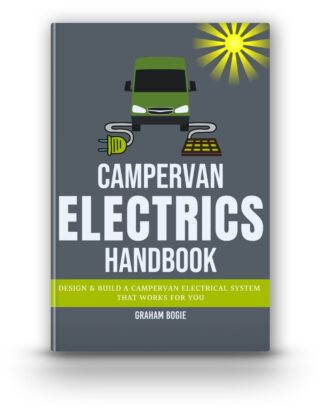
Everything you need to know about campervan electrics. Now available in ebook and paperback!
Learn how to design, size, install and troubleshoot your camper’s electrical system.
Campervan Battery Charging

Without an effective means of replacing the energy used, campervan batteries will flatten.
Not only is it important to recharge them so you can continue to use them, but if left too deeply discharged for too long, their lifespan will shorten.
We have a detailed article on charging a leisure batteries but here’s the main points.
There’s 3 ways of charging a leisure battery in a camper:
- Charging batteries while driving
- Campervan solar panel system
- Mains hook up battery charging
Charging 12v Batteries from your Engine
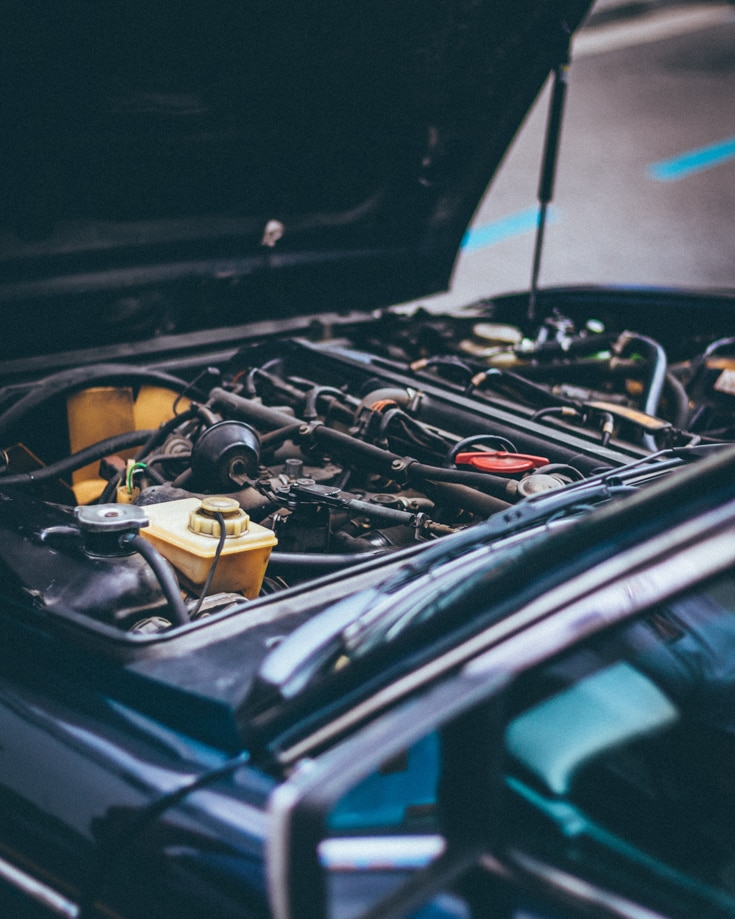
Vehicles have a 12v main starter battery fitted because they need energy to start the engine when you turn the ignition.
Main batteries give a surge of power (enough to start the engine) and they’re recharged from the energy generated by the running engine.
If the vehicle’s electrics remain on long enough after switching off the engine, the start battery could end up flat so unable to restart the engine.
Unless you only ever need an electrical supply in your campervan when your engine is running, you’re going to need a system a little more sophisticated than this.
Most campervans have 12v deep cycle leisure batteries installed, designed for a gradual release of energy.
It’s a separate set up to the main battery so you can start your engine, regardless of the supply available or voltage in your leisure batteries.
Using the engine to charge your leisure batteries is an efficient way to top up. Well, so long as you’re not running the engine just to charge your batteries.
There are 3 ways you can install this:
- Split charge relay on your main battery
- Battery to battery charging
- Separate alternator
Split Charge Relay
A split charge relay fitted to your vehicle’s alternator output, prioritises the charge between the main and leisure batteries when the engine is running.
The main battery receives all the power until it’s fully charged. All power is then allocated to charging your leisure batteries.
In the event the leisure battery runs low, you could run your engine to top it up.
The downside is you’ll need to carry out some emergency repairs to charge the batteries if the relay fails.
Battery to Battery Charging
In modern vehicles with smart alternators, the alternator drastically reduces its output once the starter battery is charged.
For motorhomes, RVs and campervans tapping into this inbuilt generator is an ideal opportunity to recharge the house batteries.
A battery to battery charger allows both the starter battery and the leisure batteries to charge at the same time when the vehicle’s engine is running.
Unlike a split charge relay though, the B2B charger is intelligent, providing a more controlled charge.
So if the engine is running long enough, a B2B charger can charge the leisure batteries fully.
Separate Alternator
To protect your main battery, you can fit a separate alternator to the engine as a dedicated charge to the leisure batteries.
The running engine charges both main and auxiliary batteries, leveraging otherwise redundant power.
If the main battery alternator fails, you could rewire to the auxiliary alternator if you know what you’re doing.
This is a pretty expensive solution and unless you plan to travel to remote corners of the world and need to protect the engine’s main alternator, is perhaps overkill.
How long do you need to run your engine (or drive) to recharge your batteries?
The calculation is like the hook up calculation below only you replace the battery charger amp hours with the amount of amps the alternator delivers to your battery bank.
You need to check the rating of your alternator, split charge relay or B2B charger to identify how many amps it produces.
We had a separate alternator in Mowgli (our unimog) and it produced 100 Ah with the engine running over 1200rpm (so when we’re driving).
At idle it produces 50 Ah.
For a half full, 140ah battery with a maximum charge current of 30 amps, we need to recharge 70 amp hours.
With an alternator rated at 100 Ah, in theory we need to drive just over 2 hours to recharge our battery bank.
In reality, only a battery to battery charger allows the battery bank to be fully recharged from the engine. An alternator or split charge relay will only ever bring them up to about 80%.
Campervan Solar Panel System
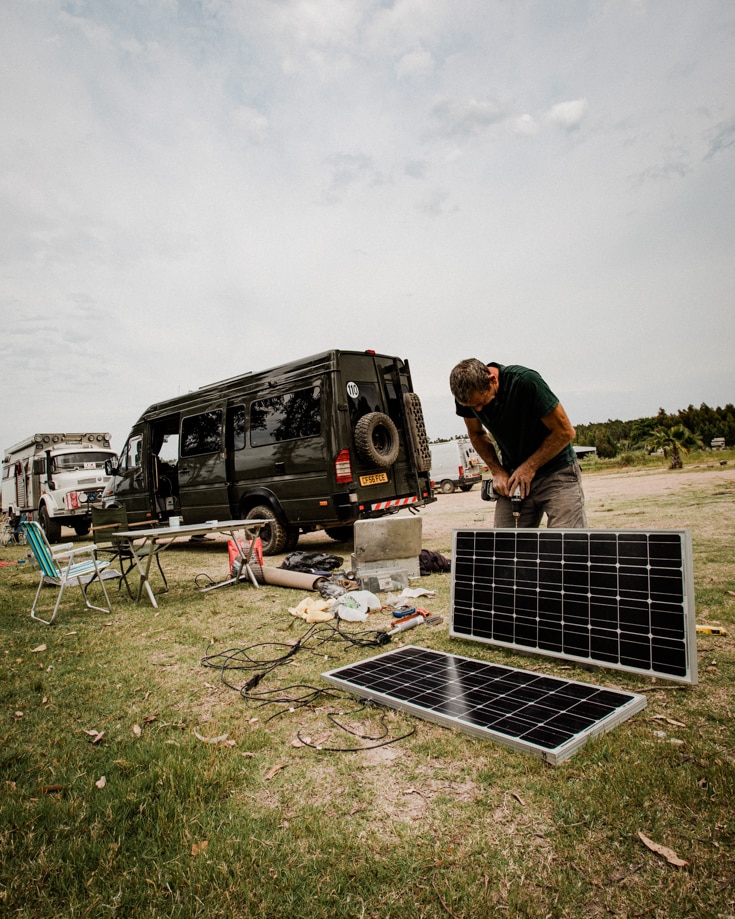
Using campervan solar power to charge van batteries is increasing in popularity, with advancements in technology and reducing prices fuelling its use.
You can fit rigid or flexible panels to your roof, or have portable panels, propping them up when you’re stationary.
After living in the van full time since 2018, we recommend rigid solar panels. You can read more about this in our post on camper solar panels.
You need to fit a charge controller to convert the solar panel output into a consistent 12 volt DC charge. Then all you need is daylight.
We have a 130 watt and 2 x 95 watt monocrystalline solar panels on the roof of our Sprinter conversion and we can live off grid permanently.
Not too shoddy!
How much sun do you need to recharge your batteries?

So this calculation is a little more speculative because the energy from daylight is inconsistent. The sun isn’t in the best position to deliver energy to the solar panels all day.
Shade and cloud will interfere with the level of energy delivered too. So to try to keep it simple, let’s assume we get 4 hours of full sun daylight per day.
Now we’ll calculate how many amps a 100w solar panel could generate.
For each full hour of full sun, a 100w panel can generate 100 watts of energy. Our battery is a 12v battery.
To calculate amps, we divide watts by volts. So our 100w solar panel could generate 100 watts/12 volts = 8.3 amps each hour.
In our working example, we need to generate 70 amps to recharge our camper van batteries and at 8.3 amps per hour, we need about 8.5 hours of full sun on one 100w solar panel.
If we have 4 solar panels each of 100w on the roof of our Sprinter so in theory, with full sun for a little over 2 hours, we’d recharge our 140 amp hour batteries.
You can guess by now, the reality is somewhat different. Because of inefficiency of the panels and charger, the battery doesn’t receive all the amps delivered.
These figures are for illustrative purposes. For a more accurate calculation check out our campervan solar calculator to size your complete setup.
Wind power
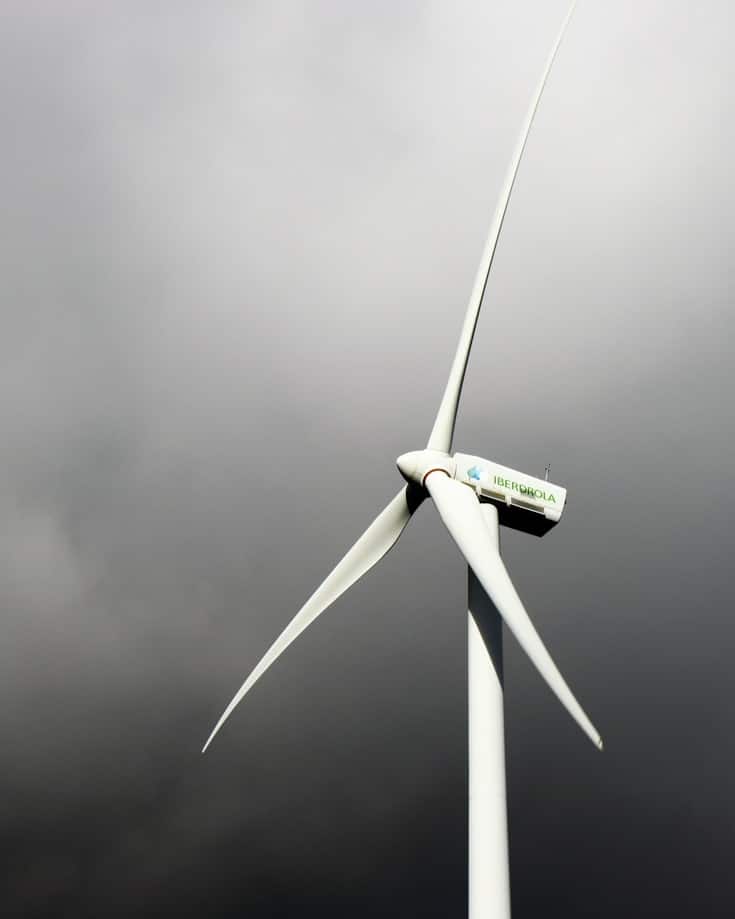
As with solar power, wind provides free energy and tapping into this is a great way to charge your campervan leisure batteries.
Wind power is less common on campervans though common on sail boats.
Installation is pretty much the same as with solar panels although you also need to consider mounting the wind turbine.
Don’t forget to make it demountable to avoid wrecking it as you travel.
The added benefit is the wind turbine charges 24/7, assuming the wind is blowing!
Mains Hook Up Battery Charging
Besides charging the leisure battery from the engine, you can also use a mains hook up facility.
By fitting a battery charger (also known as a power converter), you can convert the 110v or 240 v AC mains supply to the 12 volts DC needed to charge the battery.
This allows you to plug the battery charger into the shore power and trickle charge the leisure batteries.
While you’re hooked up, you can pretty much use electricity as you would in a house so you don’t need to worry about your batteries too much.
Here’s our detailed post on how to install and use shore power hook up on campsites.
It gives loads of useful information on safety, cables you need and how to connect on site.
How long do you need hook up to recharge your batteries?
To recharge your battery bank from a hook up, you need a battery charger fitted to convert the 240v AC supply to a 12v DC supply.
The size of the battery charger determines hook up time needed.
Let’s assume we have a 20 amp hour battery charger unit.
Let’s say we have a battery bank of 140 amp hours at 50% empty. So we need to recharge 70 amp hours.
With a 20 Ah battery charger fitted, in theory we need to hook up for 3.5 hours to recharge.
In reality even charging batteries isn’t 100% efficient so we need to make an allowance.
Again, we assume 50% efficiency so to recharge our 140Ah batteries from hook up, we’d reckon on around 7 hours.
Power from a Generator for your Campervan

A portable generator also produces AC electricity so this provides the option of packing a generator to act like a campsite hook up.
We’re not big fans because they’re noisy (ish) when running.
Plus we’d also need to carry petrol and lifting heavy equipment in and out of the vehicle is a tad awkward.
Choosing how to charge campervan’s leisure batteries is in part about your expected usage but also how you plan to live your van life.
If you only intend to stay at campsites and willing to pay a little extra for shoreline hook up, then you can get away with a low capacity battery bank and use as much electricity as you like while in situ.
If you’re hoping to live more off grid, don’t want to drive every day and have a few appliances needing electricity, you need to consider installing a solar power and a split charge relay or B2B charger.
In reality, most camper van owners will choose 2 or 3 charging methods.
Here’s how we charge our own leisure batteries.
How Much Energy we Generate in our Camper
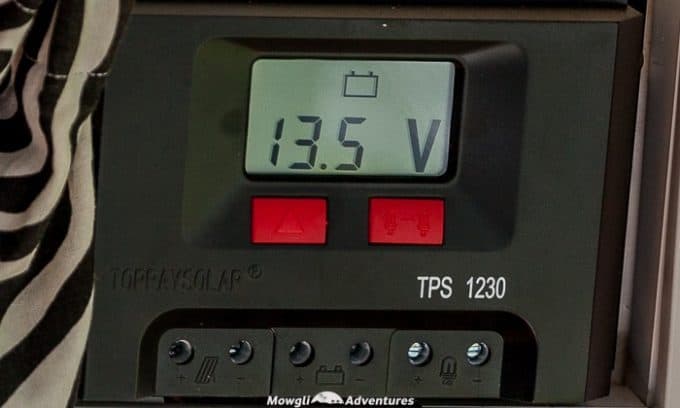
We don’t use hook up often so rely on the solar panels and driving to generate enough energy.
When we lived in Mowgli, the Unimog, we didn’t worry too much about our batteries.
We travelled through Africa so got plenty of sun on our solar panels to keep our batteries topped up.
Now we live and travel in a Baloo, our Sprinter conversion, and our setup is even more ideal.
We’ve just survived a Patagonian winter with no driving or hookup.
With careful use, we managed just fine!
How to Use Appliances in a Campervan
Electrical appliances use either direct current (DC power) or alternative current (AC power).
Mains power supplied to typical homes and businesses is AC power so most household appliances run on AC.
Generally speaking, any appliance powered by plugging it into a wall socket uses AC. Think about appliances like washing machines, TVs, microwaves and hairdryers – they all run on AC power.
DC appliances tend to be less power hungry. Gadgets you can plug into cigarette lighters or USBs typically run on DC power.
Because AC power cannot be stored, the camper’s 12v batteries provide all the power when living off grid.
Using energy efficient 12v DC appliances helps reduce overall demand.
12v appliances for campers are widely available including LED lights, heaters, ventilation fans and even fridges so minimising AC appliances is easy.
But what about running AC appliances when off grid?
Most laptops, TVs, camera battery and power tool chargers need an AC power supply. Without hook up, battery’s DC power can be converted to AC by installing a power inverter.
We recommend using the smallest inverter you can get away with and you can use our inverter calculator to figure this out.
12v Battery Monitoring System
Campervan electrics are at the heart of a van living so keeping an eye on the health of the batteries is important.
A battery monitoring system can:
- measure battery voltage so indicating how charged it is
- indicate when it’s receiving a charge (so you can see if your solar, hookup or alternator charging are working)
- help prevent you over-discharging them (important for lead-acid batteries)
- monitor use in real time
There are some really high end battery monitoring systems available but a simple LED voltmeter is the minimum we recommend.
Wiring, Fuses & Breakers
In the event of appliance faults or power surges, fuses & breakers protect the campervan electrics wiring and battery.
It’s important to install the right size fuses and breakers so should too much current travel down the wire, it will blow the fuse, protecting the entire system.
Sizing campervan wiring for each appliance on the circuit is important too. It should be big enough to cope with the maximum load on the wire and preferably not so big as to lead to unnecessary spend.
Automatically Create Your Bespoke RV Wiring Diagram
Includes 110v & 240v, solar, B2B, batteries, inverters, 12v, 24v & 48v systems, wire gauges in AWG & mm² & much more!

Top Tips for Managing your Campervan Electrics
- Minimise your energy demand by choosing efficient appliances. Always compare the Ah ratings of alternative products before you buy. Some manufacturers display amp hours (Ah); others show watts. Convert watts to amps by dividing watts by 12 volts.
- Where possible, choose 12v appliances because they’re more efficient than AC alternatives.
- Remember you need a power inverter to use AC appliances in your camper. The inverter also uses energy so make sure to include this in your usage calculations.
- Some cheaper versions of inverters provide a square wave as opposed to a nice, clean sine wave. Some delicate electronics such as TVs, do not work well on square waves. Ensure you invest in the right product to meet your needs.
- Where a 12v alternative appliance is available, do a quick calculation to work out which one is more efficient.
- Campervan heating without electricity is an option!
- When you open an upright fridge, more cold air is lost than when you open a box one (because cold air sinks). More energy is used to bring the upright fridges temperature back down when you close the door. Box fridges tend to have lower overall energy consumption.
- Invest in a good power management system to control and monitor your campervan electrical system.
- Use high quality marine grade components because their specification is built to withstand tough environments.
- Use the appropriate wire gauge to give you the maximum electrical efficiency, safety and practicality. Seek advice on the wire gauge to use based on the currents and voltages you expect your electrical setup to use.
- Isolate every component through fuses or isolating switches to protect the battery from voltage and current spikes. A battery isolator is an essential safety component for the electrical setup when installing your campervan wiring .
- If you lack electrical skills or confidence, this is an area where it pays to get professional assistance with the installation. After all, you don’t want an incorrectly fitted system to cause a fire!
When it comes to campervan electrics, there’s one simple rule: you must put in more than you take out.
The best advice for any overland vehicle is to keep the electrics simple and your output needs to a minimum.
Graham Bogie

Graham is a seasoned marine electrical engineer with two decades of experience designing customized electrical systems for plant machinery and converting campers and overland vehicles. His expertise has led him to author the reputable Campervan Electrics Handbook and become the chief designer of the RV Wiring Design Tool. As a knowledgeable figure in the field, his YouTube channel, blog, Facebook group, and newsletter, offering electrical advice and product reviews, reach more than a million users each year.


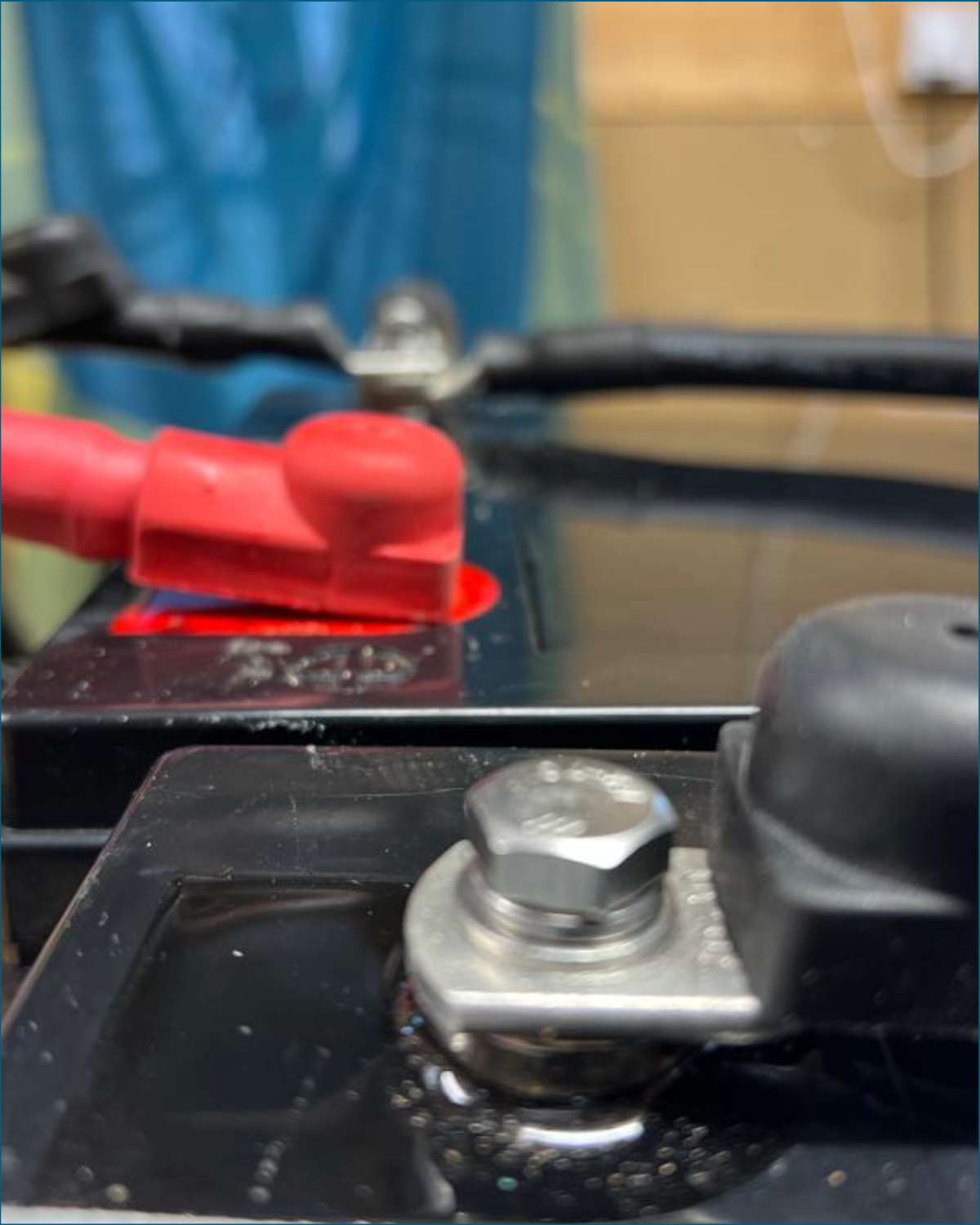

You mention converting Watts to Ah.
Note that these are not the same. Ah is energy, while Watt is power. You also need to multiply the Watts by time to get to Ah.
Good spot and you’re quite right. We’ve corrected that now. Thanks :-)
I can’t see any reference to Alarm battery? This is independent to all others isn’t it?
I can’t find mine and it’s run dry! Where is it?
I have had recently installed two lithium 100ah batteries and upgraded all the wires also installed a battery monitor system (victron)
I’m trying to figure out why my battery monitor tells me in a day I’ve used around 20ah but my battery charge level at the end of a day of use is around 40% left
Why do 200ah batteries use 60% of there energy but only show 20 ah of discharge?
Hi Mitchell, I’m not sure exactly but I’d start by checking the monitor is set for the correct battery type, it’s monitoring all the load and all connections are tight.
Other than that, it’s pretty for us difficult to fault find remotely. I hope that helps.
Angela & Graham
Hi,
I am probably going to ask a tonne of stupid questions. But I am struggling on figuring out what type of battery would be best and why as the calculations confuse me. I have given it a go but I’m not the best at working it out.
Myself and my partner are converting our van at the moment and the big thing we’re stuck on is the battery. We figured that we would most likely have
2 phones
Laptop charger
Blender
Fridge/Freezer
2 water heaters
Normal heater
AC?
Microwave
Lighting
Electrical outlets
Stove
We don’t know all of the Ah for these appliances and can’t figure out what the calculations would be as we have not bought all of them yet.
We also wondered whether it would be worth buying an inverter and converting it to AC power as opposed to DC power, as it would be easier for things like charging phones etc.
Please get back to me :)
Thank you so much.
Lauren
Hi Lauren
Batteries supply DC power i.e 12v.
Phones, laptop chargers & lighting are easy to run on 12v.
Fridges and cookers can all be purchased to run on 12v too – or bottled gas.
Heating & water heaters run on gas, diesel or some with a 12v supply.
The battery bank needs to be recharged with energy, be that from the sun, charging from your engine, external generators or via a battery charger hooked up to the mains.
To run your AC appliances like the microwave, Air Con and blender, you’d need a large inverter which alone is an inefficient use of your batteries. Those appliances running will then quickly drain said batteries. It’s probably not practical to have a battery bank big enough in a van to run all those AC appliances.
If you plan to be hooked up to mains power more often than not, then this wouldn’t be as much of a problem. If you only use them when hooked up. This way you don’t use the energy from your batteries.
In terms of the calculation, even without having purchased your DC appliances, you can still calculate your consumption needs with a few assumptions.
For each appliance, pick a product you might purchase and check the Ah. Use this as the basis of your calculation. It may not be wholly accurate but it’ll give you a fair idea.
To start calculating your needs for the AC appliances is too complicated for me. You’d need to understand the base load of the inverter, then its consumption profile based on the appliances hooked up to it. And that was complicated for me to write let alone work out :-0
My advice is to reduce your dependency on AC appliances.
I hope this helps!
Can I run the ninternal electrics eg fridge sockets and water supply to my sink without an electrical hook up
Hi Gordon. Yes you can. You run them from the batteries as long as the fridge is 12v. You should install some leisure batteries to save the main battery from draining. So you need a way to charge those batteries – solar or a smart relay will do the job.
in the battery charging equation from running engine,
battery bank capacity x battery efficiency
——————————————
Alternator Ah
the 50% efficiency works out at 30.
Where does the 30 come from? Is it the usable hours (working example giving 35 hours) rounded down?
This is the only bit i don’t understand from an otherwise very helpful and well written guide, thankyou in advance!